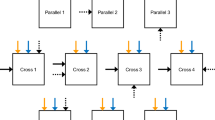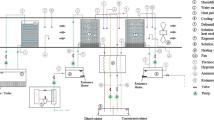Abstract
Internally-cooled dehumidifiers are efficient liquid desiccant dehumidifiers, whose performance is mainly determined by the device structure and operating conditions. Based on energy and mass conservation in the air, solution, and cooling water in the device, mathematical models are built and their theoretical performance is simulated and analyzed in this paper. A novel measure of dehumidification efficiency is introduced to evaluate the performance of internally-cooled dehumidifiers, in which the equilibrium humidity ratio of the inlet solution is calculated according to the minimum temperature in the inlet solution and the cooling water. Numerical simulations show that a counter flow between air and solution is always the most efficient, followed by cross flow, and parallel flow is the least efficient. Cooling water with the same flow direction as the solution performs better than that with a counter flow, with approximately a 5% improvement in efficiency. Compared with CaCl2, the dehumidification efficiency of a LiCl solution is greater by 60%, while its exergy efficiency is less by 16%. Dehumidification efficiency can be improved with the number of air-solution heat transfer units (NTUa-s) increasing, and reduced with the air mass flow rate raised. With NTUa-s increasing, exergy efficiency can be improved, and an increase in mass flow rate of cooling water results in a decrease of efficiency. Higher solution concentration and lower inlet temperature of solution and air can achieve both higher dehumidification efficiency and exergy efficiency.
概要
目 的
目前关于内冷型溶液除湿器的研究均基于特定的装置结构和流型, 限制了其普遍应用. 本文采用基于传热单元数的传热传质数学模型, 通过数值模拟研究了各种流型、 结构和流体参数的影响.
创新点
-
1.
提出一种新的除湿效率定义;
-
2.
引入火用效率评价内冷型除湿器的性能;
-
3.
分析不同流型、 结构和流体参数下除湿器除湿效率和火用效率;
-
4.
研究结论不受特定装置和流体参数的限制, 为内冷型除湿器的设计优化提供了建议.
方 法
-
1.
建立内冷型除湿器的物理和数学模型;
-
2.
通过实验数据与模拟数据的对比, 验证模型的正确性;
-
3.
建立除湿效率和火用效率的数学模型;
-
4.
通过不同流型、 结构和流体参数的模拟数据, 分析其对除湿效率和火用效率的影响.
结 论
-
1.
本文提出了一种新的除湿效率定义, 解决了内冷型除湿器在某些工况下除湿效率超出 0~1 范围的问题; 溶液入口平衡含湿量根据入口溶液和冷却水的最低温度计算, 并且新的除湿效率综合考虑了冷水的代价, 可以更好地评价除湿器的除湿性能.
-
2.
对于内冷型除湿器, 三种空气与溶液间流型的除湿效率和火用效率总是逆流最好, 叉流其次, 顺流最差; 溶液与冷水之间的流型对两种效率影响不大, I 流型比 II 流型提升 5% 左右.
-
3.
LiCl 溶液的除湿效率高于 CaCl2 溶液, 可以提高 60%, 但 LiCl 溶液的火用效率低于 CaCl2 溶液, 可降低 16%.
-
4.
在设计内冷型除湿器时应采用较大的空气与溶液间传热单元数, 并建议在其运行过程中使用浓度较高的溶液及入口温度较低的溶液和空气, 以达到更高的除湿效率和火用效率.
Similar content being viewed by others
References
Al-Farayedhi AA, Gandhidasan P, Al-Mutairi MA, 2002. Evaluation of heat and mass transfer coefficients in a gauze-type structured packing air dehumidifier operating with liquid desiccant. International Journal of Refrigeration, 25(3):330–339. https://doi.org/10.1016/s0140-7007(01)00016-0
Bansal P, Jain S, Moon C, 2011. Performance comparison of an adiabatic and an internally cooled structured packed-bed dehumidifier. Applied Thermal Engineering, 31(1): 14–19 https://doi.org/10.1016/j.applthermaleng.2010.06.026
Bassuoni MM, 2011. An experimental study of structured packing dehumidifier/regenerator operating with liquid desiccant. Energy, 36(5):2628–2638. https://doi.org/10.1016/j.energy.2011.02.004
Chang XM, Liu XH, Jiang Y, 2007. Performance numerical analysis on an internally-cooled liquid desiccant dehumidifier. Proceeding IBPSA International Building Performance Simulation Association Conference.
Chang XM, Liu XH, Jiang Y, 2009. Research on the heat and mass transfer performance and flow-pattern comparison of the internally-cooled liquid desiccant dehumidifiers. Acta Energiae Solaris Sinica, 30(2):170–17. (in Chinese). https://doi.org/10.3321/j.issn:0254-0096.2009.02.007
Chung TW, Wu WY, Yan WJ, et al., 1995. Efficiency of a liquid desiccant dehumidification system regenerated by using solar collectors/regenerators with photovoltaic fans. Separation Science and Technology, 30(6):1039–1045. https://doi.org/10.1080/01496399508015415
Conde MR, 2004. Properties of aqueous solutions of lithium and calcium chlorides: formulations for use in air conditioning equipment design. International Journal of Thermal Sciences, 43(4):367–382. https://doi.org/10.1016/j.ijthermalsci.2003.09.003
Dai YJ, Zhang HF, 2004. Numerical simulation and theoretical analysis of heat and mass transfer in a cross flow liquid desiccant air dehumidifier packed with honeycomb paper. Energy Conversion and Management, 45(9-10):1343–1356 https://doi.org/10.1016/j.enconman.2003.09.006
Ding T, Huang ZD, Zhao WJ, et al., 2010. Dehumidification and regeneration efficiency of the mixed salt solution in the solar dehumidification system. Transactions of the Chinese Society of Agricultural Engineering, 26(2): 295–329 (in Chinese). https://doi.org/10.3969/j.issn.1002-6819.2010.02.051
Fazilati MA, Alemrajabi AA, Sedaghat A, 2017. Liquid des-iccant air conditioning system with natural convection. Applied Thermal Engineering, 115:305–314. https://doi.org/10.1016/j.applthermaleng.2016.12.111
Gandhidasan P, 2004. A simplified model for air dehumidifi-cation with liquid desiccant. Solar Energy, 76(4):409–416. https://doi.org/10.1016/j.solener.2003.10.001
Gao WZ, Shi YR, Cheng YP, et al., 2013. Experimental study on partially internally cooled dehumidification in liquid desiccant air conditioning system. Energy and Buildings, 61:202–209. https://doi.org/10.1016/j.enbuild.2013.02.034
Gonçalves P, Angrisani G, Sasso M, et al., 2014. Exergetic analysis of a desiccant cooling system: searching for performance improvement opportunities. International Journal of Energy Research, 38(6):714–727. https://doi.org/10.1002/er.3076
Hürdoğan E, Buyükalaca O, Hepbasli A, et al., 2011. Exergetic modeling and experimental performance assessment of a novel desiccant cooling system. Energy and Buildings, 43(6):1489–1498. https://doi.org/10.1016/j.enbuild.2011.02.016
Jain S, Dhar PL, Kaushik SC, 2000. Experimental studies on the dehumidifier and regenerator of a liquid desiccant cooling system. Applied Thermal Engineering, 20(3): 253–267 https://doi.org/10.1016/s1359-4311(99)00030-7
Jain S, Bansal PK, 2007. Performance analysis of liquid desiccant dehumidification systems. International Journal of Refrigeration, 30(5):861–872. https://doi.org/10.1016/j.ijrefrig.2006.11.013
Jain S, Tripathi S, Das RS, 2011. Experimental performance of a liquid desiccant dehumidification system under tropical climates. Energy Conversion and Management, 52(6): 2461–2466 https://doi.org/10.1016/j.enconman.2010.12.052
Koronaki IP, Christodoulaki RI, Papaefthimiou VD, et al., 2013. Thermodynamic analysis of a counter flow adia-batic dehumidifier with different liquid desiccant materials. Applied Thermal Engineering, 50(1):361–373. https://doi.org/10.1016/j.applthermaleng.2012.06.043
Liu J, Zhang T, Liu XH, et al., 2015. Experimental analysis of an internally-cooled/heated liquid desiccant dehumidifier/regenerator made of thermally conductive plastic. Energy and Buildings, 99:75–86. https://doi.org/10.1016/j.enbuild.2015.04.023
Liu J, Liu XH, Zhang T, 2016. Performance comparison of three typical types of internally-cooled liquid desiccant dehumidifiers. Building and Environment, 103:134–145. https://doi.org/10.1016/j.buildenv.2016.04.006
Liu XH, Chang XM, Xia JJ, et al., 2009. Performance analysis on the internally cooled dehumidifier using liquid desiccant. Building and Environment, 44(2):299–308. https://doi.org/10.1016/j.buildenv.2008.03.009
Longo GA, Gasparella A, 2005. Experimental and theoretical analysis of heat and mass transfer in a packed column dehumidifier/regenerator with liquid desiccant. International Journal of Heat and Mass Transfer, 48(25-26): 5240–5254. https://doi.org/10.1016/j.ijheatmasstransfer.2005.07.011
Lowenstein A, 2008. Review of liquid desiccant technology for HVAC applications. HVAC&R Research, 14(6):819–839. https://doi.org/10.1080/10789669.2008.10391042
Luo YM, Shao SQ, Xu HB, et al., 2014. Experimental and theoretical research of a fin-tube type internally-cooled liquid desiccant dehumidifier. Applied Energy, 133:127–134. https://doi.org/10.1016/j.apenergy.2014.07.085
Mei L, Dai YJ, 2008. A technical review on use of liquid-desiccant dehumidification for air-conditioning application. Renewable and Sustainable Energy Reviews, 12(3): 662–689 https://doi.org/10.1016/j.rser.2006.10.006
Oberg V, Goswami DY, 1998. Experimental study of the heat and mass transfer in a packed bed liquid desiccant air dehumidifier. Journal of Solar Energy Engineering, 120(4):289–297. https://doi.org/10.1115/1.2888133
Peng DG, Zhang XS, 2016. Dehumidification efficiency model for solar thermal regeneration system. Transactions of the Chinese Society of Agricultural Engineering, 32(1):206–21. (in Chinese). https://doi.org/10.11975/j.issn.1002-6819.2016.01.029
Peng DG, Zhou JM, Luo DT, 2017. Exergy analysis of a liquid desiccant evaporative cooling system. International Journal of Refrigeration, 82:495–508. https://doi.org/10.1016/j.ijrefrig.2017.06.021
Qi RH, Lu L, 2014. Energy consumption and optimization of internally cooled/heated liquid desiccant air-conditioning system: a case study in Hong Kong. Energy, 73:801–808. https://doi.org/10.1016/j.energy.2014.06.086
Qi RH, Lu L, Yang HX, 2013. Development of simplified prediction model for internally cooled/heated liquid desiccant dehumidification system. Energy and Buildings, 59:133–142. https://doi.org/10.1016/j.enbuild.2012.12.028
Ren CQ, Tu M, Wang HH, 2007. An analytical model for heat and mass transfer processes in internally cooled or heated liquid desiccant-air contact units. International Journal of Heat and Mass Transfer, 50(17-18):3545–3555 https://doi.org/10.1016/j.ijheatmasstransfer.2006.12.034
Tu M, Ren CQ, Tang GF, et al., 2010. Performance comparison between two novel configurations of liquid desiccant air-conditioning system. Building and Environment, 45(12):2808–2816. https://doi.org/10.1016/j.buildenv.2010.06.009
Turgut OE, Coban MT, 2016. Experimental and numerical investigation on the performance of an internally cooled dehumidifier. Heat and Mass Transfer, 52(12):2707–2722. https://doi.org/10.1007/s00231-016-1782-9
Uçkan I, Yılmaz T, Hürdoğan E, et al., 2014. Exergy analysis of a novel configuration of desiccant based evaporative air conditioning system. Energy Conversion and Management, 84:524–532. https://doi.org/10.1016/j.enconman.2014.05.006
Wang L, Li NP, Zhao BW, 2010. Exergy performance and thermodynamic properties of the ideal liquid desiccant dehumidification system. Energy and Buildings, 42(12): 2437–2444 https://doi.org/10.1016/j.enbuild.2010.08.022
Xiao F, Ge GM, Niu XF, 2011. Control performance of a dedicated outdoor air system adopting liquid desiccant dehumidification. Applied Energy, 88(1):143–149. https://doi.org/10.1016/j.apenergy.2010.06.019
Xiong ZQ, Dai YJ, Wang RZ, 2010. Exergy analysis of liquid desiccant dehumidification system. International Journal of Green Energy, 7(3):241–262. https://doi.org/10.1080/15435071003795881
Yang ZL, Lian ZW, 2014. Analysis of influencing factors on performance of the LDAC system based on the concept of ideal dehumidification efficiency. Journal of Shanghai Jiaotong University, 48(6):821–82. (in Chinese).
Yin YG, Zhang XS, Wang G, et al., 2008. Experimental study on a new internally cooled/heated dehumidifier/regenerator of liquid desiccant systems. International Journal of Refrigeration, 31(5):857–866. https://doi.org/10.1016/j.ijrefrig.2007.10.004
Yin YG, Qian JF, Zhang XS, 2014. Recent advancements in liquid desiccant dehumidification technology. Renewable and Sustainable Energy Reviews, 31:38–52. https://doi.org/10.1016/j.rser.2013.11.021
Zhang L, Hihara E, Matsuoka F, et al., 2010. Experimental analysis of mass transfer in adiabatic structured packing dehumidifier/regenerator with liquid desiccant. International Journal of Heat and Mass Transfer, 53(13-14): 2856–2863. https://doi.org/10.1016/j.ijheatmasstransfer.2010.02.012
Zhang T, Liu XH, Jiang JJ, et al., 2013. Experimental analysis of an internally-cooled liquid desiccant dehumidifier. Building and Environment, 63:1–10. https://doi.org/10.1016/j.buildenv.2013.01.007
Zhang T, Liu XH, Liu J, et al., 2017. Exergy and entransy analyses in air-conditioning system. Part 2-humid air handling process. Energy and Buildings, 139:10–21. https://doi.org/10.1016/j.enbuild.2017.01.004
Zhu MS, 1988. Exergy Analysis of Energy Systems. Tsinghua University Press, Beijing, China (in Chinese).
Author information
Authors and Affiliations
Contributions
Dong-gen PENG designed the research and edited the manuscript, Shun-yi LI processed the corresponding data and wrote the first draft of the manuscript, Dan-ting LUO conducted the research, Yu-ting FU revised the manuscript, Xiao-song CHENG helped organize the manuscript, and Yin LIU revised and edited the final version.
Corresponding author
Ethics declarations
Dong-gen PENG, Shun-yi LI, Dan-ting LUO, Yu-ting FU, Xiao-song CHENG, and Yin LIU declare that they have no conflict of interest.
Additional information
Project supported by the National Natural Science Foundation of China (No. 51766010), the Knowledge Innovative Team of High-efficient Refrigeration in Nanchang City of China (No. 2018-CXTD-004), the Special Fund Project for Graduate Innovation of Nanchang University (No. CX2018058), the Zhihui Zhengzhou 1125 Talent Gathering Plan Innovation and Entrepreneurship Leading Team, and the Study Plan for Young and Middle-aged Teachers in Nanchang University, China
Rights and permissions
About this article
Cite this article
Peng, Dg., Li, Sy., Luo, Dt. et al. Efficiency comparison and performance analysis of internally-cooled liquid desiccant dehumidifiers using LiCl and CaCl2 aqueous solutions. J. Zhejiang Univ. Sci. A 21, 44–63 (2020). https://doi.org/10.1631/jzus.A1900241
Received:
Accepted:
Published:
Issue Date:
DOI: https://doi.org/10.1631/jzus.A1900241
Key words
- Liquid desiccant
- Internally-cooled dehumidifiers
- Performance comparison
- Dehumidification efficiency
- Exergy efficiency




